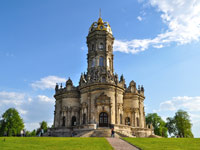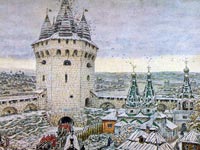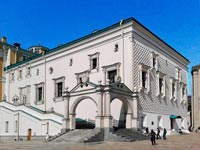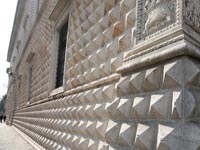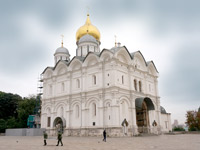Russia, 199034, St. Petersburg, Line 14th V.O., house 7, letter A, BC "Preobrazhensky"

(812) 322-09-40
(812) 322-34-40
White stone
However, if we consider the most famous buildings of ancient Russia - Rus white-stone, it turns out that the buildings or their parts, on the territory of Moscow and Moscow region, Ryazan, Yaroslavl, Nizhny Novgorod, Vladimir, and even Astrakhan and Arkhangelsk regions are made of limestone, mined in the Moscow region, in the area of ancient villages Myachkov, Tuchkov and Domodedovo. Starting from the XII. near the mouth of the river. Pakhry, and on the banks of the Moscow River in the quarries, and partly in the underground workings, tunnels, mining of this sedimentary, detrital, carbonate rock, formed in these places 230-240 million years ago as a product of a long change and petrification of skeletal remains of countless living organisms that lived in the deep sea.
In other words, the white stone and the well-known Myachkovsky limestone can be considered practically synonymous with reference to the Old Russian architecture. Of course, at that time, white stone was mined in other places, for example, near the city of Staritsa on the Volga or near Kasimov on the Oka, but much smaller in scale.
Its strength characteristics are good enough, so the buildings passed the test of time in several centuries. Some physicomechanical properties of limestone are presented by Myachkovsky - extreme indicators from I to IV quality classes are given. Hereinafter, the "White Stone" A.M. Viktorov, L.I. Zvyagintsev. Ed. "Science", 1981. Learn more about the physical characteristics of Granite properties and application and Marble properties and application.
These figures show that this type of stone almost does not lose strength even after 100 cycles of freezing and thawing, and sometimes even after 400. An example of longevity could be the ruins of an unfinished (until recently, recreated and turned into a museum) palace in Tsaritsyno. His carved white stone details were subjected to natural cycles of freezing, thawing and natural destruction, in spite of this, they lasted for 200 years without repairs and other positive effects.
Probably the most common phrase is "Moscow white stone" . And not by chance. In 1367 Dmitry Donskoy, the walls of the Moscow Kremlin were first rebuilt from stone - from Myachkovsky white limestone. The lower part of these walls was preserved by fragments later, during the subsequent restructuring of the Kremlin, and still serves as the foundation for the existing walls. Ancient Russia did not yet know a similar scale of white-stone works by that moment. It was calculated that for laying walls (and they were laid out in two rows, with a total width of 2-3 m, with filling, ie filling, the internal space with stone fragments on a lime mortar) 14,370 m3 were used, for buta-39 600m3, just needed to extract more than 50,000m3 of limestone. With a daily 10-hour working day, 41.5 thousand people would be needed. To ensure construction in the winter, it was necessary to use 230,000 sleds to deliver the stone. Unprecedented logistics! Construction of the century!
The largest white-stone structure of the Kremlin and the oldest is the Assumption Cathedral , built by Aristotle Fiorovanti by 1479. It is laid out of smoothly hewn blocks of Myachkovsky limestone with dimensions of 45x40x40cm and other sizes.
From the point of view of stone-cutting art, you can pay attention to the Faceted Chamber , ibid in the Kremlin, built from 1487 to 1491, and rebuilt in 1680 after the fire, the windows were decorated with white stone carved columns. The name "Faceted" comes from the faceted rusto of the main facade facing the Cathedral Square, on a plain background of light give an unusual play of light and shadow, changing depending on the lighting, and create the impression of a "diamond galley". Perhaps this reception "came" to us from Bologna. Since Sanutti Bevilacqua’s palazzo in Bologna (1477-1482) is the earliest model among Italian counterparts, others appeared in the last decade of the 14th century, after the Faceted Chamber was built - the Diamond Palace in Ferrara (1493) and the Palazzo Raimondi in Cremona. They are distinguished by another material — marble — a rock, though of the same carbonate composition as limestone, but characterized by a solid crystalline structure. Since Marble is a metamorphic, more dense rock, which is a “derivative” of limestone modified by pressure and deep temperatures, and being much less porous and at the same time fine-grained, can be polished to a mirror shine than the limestone cannot boast. The stone from which the "cut" in the form of pyramids should be relatively soft, allowing it to be cut and hewed, along with that viscous, so that when you hit tesla or chisel, do not crack and peel, because even a small break-off during diamond routing this is seen in the Diamond Palace in Ferrara) spoils the whole look. All these necessary qualities possessed only Myachkovsky limestone. Other types of limestone from the Moscow Region deposits and Moscow quarries did not have such a texture (except for the interlayers of the so-called “Podilsky marble”), they were more solid, dolomitic, often silicified.
Other many buildings of the Moscow Kremlin have white-stone foundations (like Ivan the Great Bell Tower ) or socles, sometimes quite tall, made of hewn blocks, like Archangel Cathedral (to a height of 2.5 m). In addition, its staircase entrances, pilasters of the first tier, portals, archivolts and cornices are made of Myachkovo white stone. In addition, as the tomb of all Russian rulers until the 18th century, and their close relatives, the Archangel Cathedral is the guardian of 45 white-stone ornamented sarcophagi. The basement of St. Basil’s Cathedral is also made of the same limestone.







 Site search
Site search